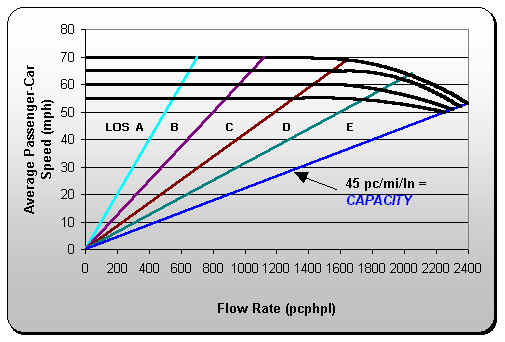


|

Level of Service Criteria
Six levels of service have been defined for roadways
and have been given letter designations of A through F. LOS A represents the best level of
service and LOS F represents the worst. The following table lists the criteria for each
LOS, based on the free-flow speed.
Level
of Service |
Maximum
Density (pc/mi/ln) |
Minimum
Speed (mph) |
Maximum
Service Flow Rate (pcphpl) |
Maximum
v/c* Ratio |
Free-Flow Speed = 70 mph |
A |
10 |
70.0 |
700 |
0.29 |
B |
16 |
70.0 |
1,120 |
0.47 |
C |
24 |
68.0 |
1,632 |
0.68 |
D |
32 |
64.0 |
2,048 |
0.85 |
E |
45 |
53.0 |
2,400 |
1.00 |
F |
var |
var |
var |
var |
Free-Flow Speed = 65 mph |
A |
10 |
65.0 |
650 |
0.28 |
B |
16 |
65.0 |
1,040 |
0.44 |
C |
24 |
64.5 |
1,548 |
0.66 |
D |
32 |
62.0 |
1,984 |
0.84 |
E |
45 |
52.0 |
2,350 |
1.00 |
F |
var |
var |
var |
var |
Free-Flow Speed = 60 mph |
A |
10 |
60.0 |
600 |
0.26 |
B |
16 |
60.0 |
960 |
0.42 |
C |
24 |
60.5 |
1,440 |
0.63 |
D |
32 |
58.0 |
1,856 |
0.81 |
E |
45 |
51.0 |
2,300 |
1.00 |
F |
var |
var |
var |
var |
Free-Flow Speed = 55 mph |
A |
10 |
55.0 |
550 |
0.24 |
B |
16 |
55.0 |
880 |
0.39 |
C |
24 |
55.0 |
1,320 |
0.59 |
D |
32 |
54.5 |
1,744 |
0.78 |
E |
45 |
50.0 |
2,250 |
1.00 |
F |
var |
var |
var |
var |
*See Terms and Definitions
To illustrate where each LOS falls with respect to
speed and flow rate, the chart below shows speed versus flow rate with corresponding
levels of service A through E. LOS F lies beyond LOS E. The value of the slope of each
line that separates the levels of service is the maximum density for that level of
service.

For example, the line drawn for LOS E extends from the end of the free-flow speed lines
to the origin and has a slope of 45.0 pc/mi/ln. Service flow rate E is the value that
corresponds to the maximum flow rate, or capacity. Service flows C or D are usually used
for most design or planning purposes because these levels of service are more acceptable
to roadway users. Note that the flow rate at capacity for a free-flow speed of 70 mph is
2400 pcphpl. This capacity represents ideal traffic and roadway conditions. Also note that
the value of capacity varies with the free-flow speed.
|